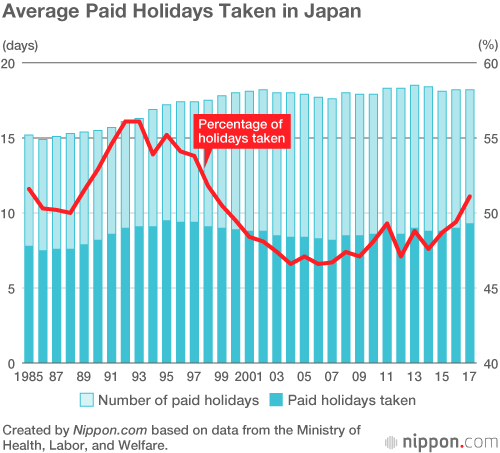
Japanese Employees Still Only Taking Half of Paid Leave
Society- English
- 日本語
- 简体字
- 繁體字
- Français
- Español
- العربية
- Русский
The average number of paid vacation days taken by employees of Japanese private companies finally reached 51.1% in 2017, surpassing the 50% level for the first time since 1999. According to a general survey on employment conditions conducted by the Ministry of Health, Labor, and Welfare, the average rose year-on-year by 1.7 percentage points, marking the third straight annual increase. The survey, conducted in January 2018, targeted around 6,400 companies that have a workforce of 30 employees or more.
The government’s long-term strategy, approved by the Cabinet in 2010, set a 70% target for average use of paid vacation days by 2020. Despite the measures that have been taken to alleviate the problem of long working hours, under the banner of “work-style reform” raised by the Abe administration that took power in 2012, the proportion of paid holidays taken by workers on average had continued to hover below the 50% mark.

In 2017, workers on average took 9.3 days of the 18.2 days entitled to them, a 0.3-day increase over the previous year. Compared to Europe and North America, where workers use nearly all of their paid holidays, Japanese seem reluctant to take a break. Starting from April 2019, companies in Japan will incur a fine of up to ¥300,000 if their employees do not take at least five paid holidays, but still many seem reluctant to take days off work for reasons that include not wanting to “inconvenience coworkers.” Given such deep-rooted attitudes, there is still a long way to go before the 70% target set by the government can be reached.
In terms of the breakdown by job category, workers in the electricity, gas, heating, and water sectors take the highest proportion of paid holidays, at 72.9%. In contrast, some other workers only take around a third of their paid holidays, including hotel and restaurant workers at 32.5%, followed by retailers at 35.8%, lifestyle-service and entertainment providers at 36.5%, and construction workers at 38.5%. The breakdown for gender is 47.5% for men and 57.0% for women.
(Translated from Japanese. Banner photo © Pixta.)